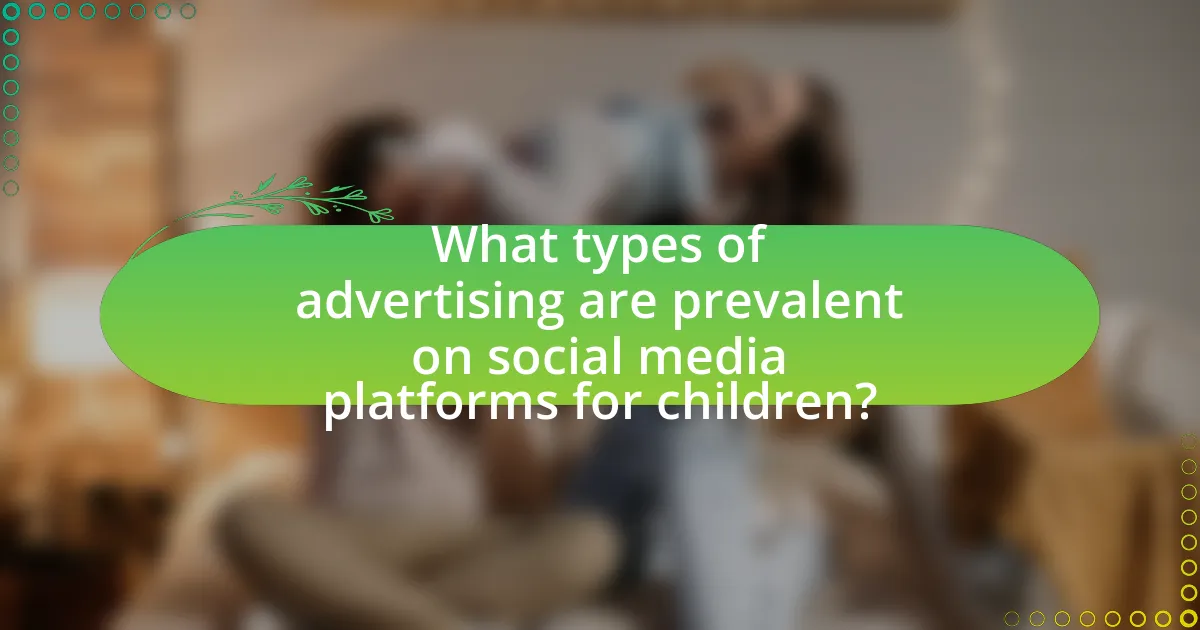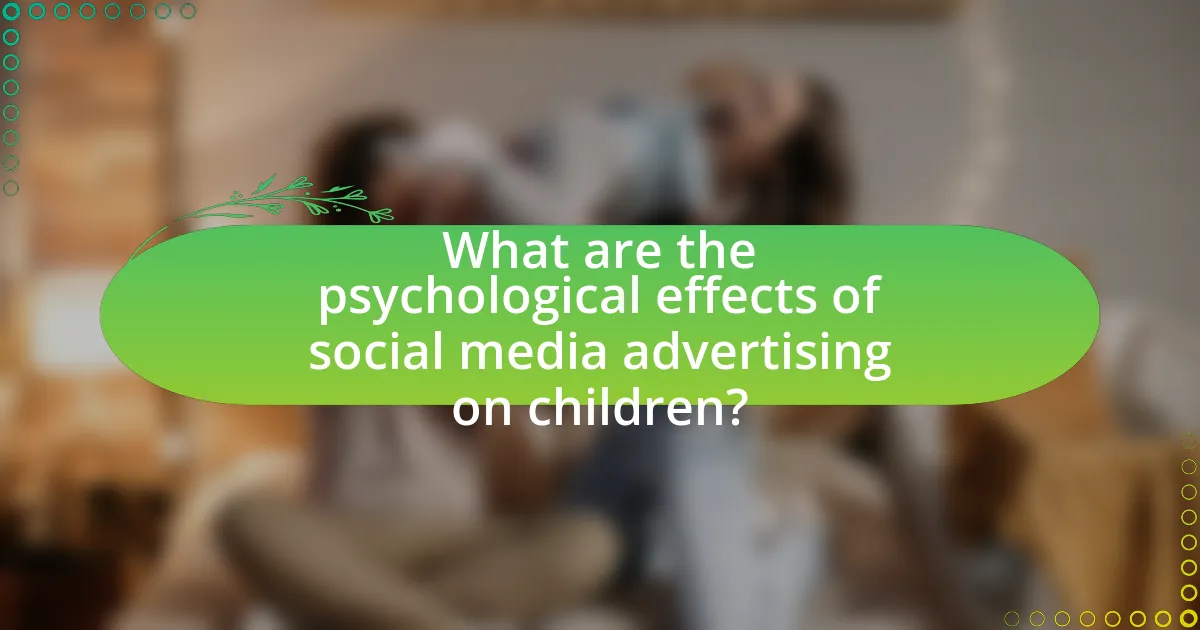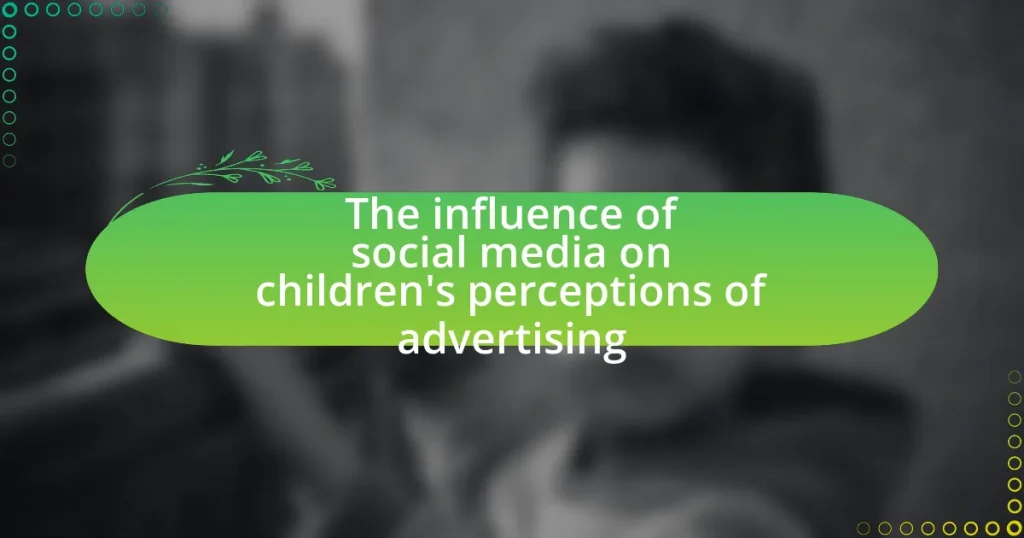The article examines the influence of social media on children’s perceptions of advertising, highlighting how platforms like Instagram and TikTok shape their understanding of brands and marketing strategies. It discusses the challenges children face in distinguishing between content and advertising, particularly due to targeted ads and influencer promotions. Key elements such as visual content, peer influence, and advertising techniques are explored, along with the developmental stages that affect children’s interpretation of ads. The article emphasizes the importance of studying these perceptions to inform better advertising practices and protect children from potentially harmful marketing strategies. Additionally, it outlines the psychological effects of social media advertising on children’s self-esteem and materialism, while also addressing strategies for parents and ethical guidelines for advertisers.
What is the influence of social media on children’s perceptions of advertising?
Social media significantly influences children’s perceptions of advertising by shaping their understanding of brands and marketing strategies. Children are exposed to targeted advertisements and influencer promotions on platforms like Instagram and TikTok, which can lead to increased brand recognition and preference. Research indicates that children often struggle to distinguish between content and advertising, making them more susceptible to persuasive marketing tactics. For instance, a study published in the journal “Pediatrics” found that children aged 8 to 12 are more likely to engage with ads presented in a social media context compared to traditional media, highlighting the effectiveness of social media in altering their perceptions of advertising.
How does social media shape children’s understanding of advertising?
Social media shapes children’s understanding of advertising by exposing them to targeted marketing strategies that blend seamlessly with entertainment content. Children often encounter advertisements disguised as organic posts or influencer endorsements, which can lead to difficulty distinguishing between genuine content and promotional material. Research indicates that children aged 8 to 12 are particularly susceptible to these tactics, as they may not fully grasp the persuasive intent behind advertisements. A study published in the journal “Pediatrics” found that children exposed to social media advertising are more likely to develop brand loyalty and positive attitudes toward advertised products, highlighting the significant impact of social media on their perceptions of advertising.
What are the key elements of social media that affect children’s perceptions?
The key elements of social media that affect children’s perceptions include visual content, peer influence, and advertising techniques. Visual content, such as images and videos, captures children’s attention and shapes their understanding of products and lifestyles. Peer influence is significant, as children often look to their friends and social circles for validation and trends, which can alter their perceptions of what is desirable or acceptable. Advertising techniques, including targeted ads and influencer marketing, are designed to appeal to children’s emotions and aspirations, further shaping their perceptions of brands and products. Research indicates that children are particularly susceptible to these elements, as they may not fully understand the persuasive intent behind social media content, leading to skewed perceptions of reality and consumerism.
How do children’s developmental stages influence their interpretation of advertising on social media?
Children’s developmental stages significantly influence their interpretation of advertising on social media by affecting their cognitive abilities, emotional understanding, and social awareness. Younger children, typically in the preoperational stage, may struggle to differentiate between entertainment and advertising, often viewing ads as part of the content rather than as persuasive messages. As children progress into the concrete operational stage, they begin to understand the intent behind advertisements but may still be easily swayed by emotional appeals and colorful visuals. Research indicates that by the time children reach the formal operational stage, around age 12, they develop critical thinking skills that enable them to analyze and question advertising messages more effectively. This progression highlights how cognitive development shapes their susceptibility to marketing tactics, with younger children being more impressionable and older children becoming more discerning consumers.
Why is it important to study children’s perceptions of advertising on social media?
Studying children’s perceptions of advertising on social media is crucial because it helps understand how young audiences interpret and respond to marketing messages. Children are particularly impressionable and may not possess the critical thinking skills necessary to discern advertising intent, making them vulnerable to manipulation. Research indicates that children aged 8 to 12 are increasingly exposed to digital advertising, with studies showing that they can recognize brand logos and advertisements but often struggle to understand the persuasive nature of these messages. For instance, a study published in the Journal of Advertising Research found that children are more likely to accept advertising claims as true compared to adults, highlighting the need for targeted research in this area. Understanding these perceptions can inform better advertising practices, promote media literacy, and guide regulatory policies to protect children from potentially harmful advertising strategies.
What potential impacts can social media advertising have on children’s behavior and choices?
Social media advertising can significantly influence children’s behavior and choices by shaping their preferences and consumption patterns. Research indicates that children exposed to targeted advertisements on platforms like Instagram and TikTok are more likely to develop brand loyalty and make impulsive purchasing decisions. A study published in the journal “Pediatrics” found that children who frequently engage with social media are more susceptible to peer pressure related to product trends, leading to increased materialism and unhealthy lifestyle choices. Furthermore, the persuasive nature of social media ads, often featuring influencers and relatable content, can distort children’s understanding of needs versus wants, impacting their decision-making processes.
How do children’s perceptions of advertising differ from adults’ perceptions?
Children’s perceptions of advertising differ from adults’ perceptions primarily in their ability to critically analyze the content. Children often view advertisements as entertainment and may not recognize persuasive intent, while adults are more likely to understand the underlying marketing strategies. Research indicates that children, particularly under the age of 8, are less capable of distinguishing between advertising and regular content, leading them to accept promotional messages at face value. In contrast, adults typically possess the cognitive skills to evaluate and question the credibility of advertisements, influenced by their life experiences and understanding of marketing tactics. This difference is supported by studies such as those conducted by the American Psychological Association, which highlight that children’s cognitive development affects their interpretation of advertising messages.

What types of advertising are prevalent on social media platforms for children?
The types of advertising prevalent on social media platforms for children include influencer marketing, sponsored content, and interactive ads. Influencer marketing involves popular figures promoting products to their young followers, which can significantly impact children’s purchasing decisions. Sponsored content often appears as engaging posts or videos that blend seamlessly with regular content, making it appealing to children. Interactive ads, such as games or quizzes, encourage participation and can create a more immersive experience, further influencing children’s perceptions of brands. Research indicates that children are particularly susceptible to these advertising formats due to their limited ability to discern between entertainment and marketing, highlighting the effectiveness of these strategies in shaping their views on products.
What are the most common forms of advertising targeted at children on social media?
The most common forms of advertising targeted at children on social media include influencer marketing, video ads, and interactive content such as games and quizzes. Influencer marketing leverages popular figures among children to promote products, often leading to higher engagement rates. Video ads, particularly those on platforms like YouTube, capture children’s attention through entertaining content, with studies indicating that children are more likely to remember brands featured in videos. Interactive content engages children directly, encouraging participation and making the advertising experience more immersive. These methods are effective due to children’s familiarity with social media and their tendency to trust peer recommendations, as highlighted in research by the American Psychological Association, which emphasizes the impact of social media on children’s brand perceptions.
How do influencers and sponsored content affect children’s perceptions of brands?
Influencers and sponsored content significantly shape children’s perceptions of brands by creating relatable and aspirational connections. Research indicates that children often view influencers as peers, which enhances their trust and affinity towards the brands promoted by these figures. A study published in the Journal of Advertising Research found that children aged 8 to 12 are more likely to develop positive attitudes towards brands when they are endorsed by influencers they admire, as these endorsements are perceived as authentic and engaging. This phenomenon is further supported by the fact that children are more susceptible to persuasive messaging, making them more likely to internalize brand values presented through influencer content.
What role do interactive advertisements play in shaping children’s views?
Interactive advertisements significantly shape children’s views by engaging them in a participatory experience that enhances brand recall and emotional connection. Research indicates that children are more likely to remember and favor brands that utilize interactive elements, such as games or quizzes, compared to traditional advertisements. A study published in the Journal of Advertising Research found that interactive ads increased children’s engagement levels by 50%, leading to a stronger association with the advertised products. This heightened engagement influences their perceptions, making them more receptive to brand messaging and potentially altering their preferences and purchasing behaviors.
How do different social media platforms influence children’s perceptions of advertising?
Different social media platforms significantly influence children’s perceptions of advertising by shaping their understanding of brand messaging and consumer behavior. For instance, platforms like Instagram and TikTok utilize visually engaging content and influencer marketing, which can lead children to perceive advertisements as more relatable and trustworthy compared to traditional media. Research indicates that children are more likely to engage with ads presented in a social context, as seen in a study published in the Journal of Advertising Research, which found that 70% of children aged 8-12 reported feeling more connected to brands when they saw them endorsed by influencers they follow. This connection can alter their perception, making them more receptive to advertising messages. Additionally, the interactive nature of platforms like YouTube allows children to engage with content, further blurring the lines between entertainment and advertising, which can lead to a normalization of consumerism in their daily lives.
What unique features of platforms like Instagram and TikTok impact children’s understanding of ads?
Platforms like Instagram and TikTok utilize unique features such as algorithm-driven content curation, short-form video formats, and influencer partnerships, which significantly shape children’s understanding of advertisements. The algorithmic nature of these platforms prioritizes engaging content, often blurring the lines between organic posts and sponsored ads, making it challenging for children to distinguish between entertainment and advertising. Additionally, the short-form video format encourages rapid consumption, which can lead to less critical engagement with the content, including ads. Influencer partnerships further complicate this understanding, as children may perceive influencers as relatable figures rather than traditional advertisers, thereby increasing the effectiveness of the ads. Research indicates that children are particularly susceptible to these marketing strategies, as they often lack the cognitive skills to critically analyze the intent behind the content they consume.
How does the age demographic of users on various platforms affect advertising strategies?
The age demographic of users on various platforms significantly influences advertising strategies by determining the content, tone, and channels used for marketing. Younger audiences, particularly children and teenagers, are more engaged on platforms like TikTok and Instagram, prompting advertisers to create visually appealing and interactive content that resonates with their interests. For instance, a study by the Pew Research Center in 2021 found that 85% of teens use YouTube, indicating that brands targeting this demographic should prioritize video content on that platform to effectively capture attention. Conversely, older demographics may prefer platforms like Facebook or LinkedIn, where advertisers can focus on informative and professional content. This differentiation in platform usage necessitates tailored advertising approaches that align with the preferences and behaviors of each age group, ensuring that marketing efforts are both relevant and effective.

What are the psychological effects of social media advertising on children?
Social media advertising significantly impacts children’s psychological development, leading to increased materialism, body image issues, and diminished self-esteem. Research indicates that exposure to idealized images and lifestyles in advertisements can create unrealistic expectations, fostering feelings of inadequacy among children. A study published in the journal “Pediatrics” found that children exposed to social media advertising are more likely to develop a desire for products that promise social acceptance and popularity, which can exacerbate anxiety and depression. Furthermore, the persuasive nature of social media ads can lead to impulsive buying behaviors, as children may struggle to differentiate between entertainment and advertising, ultimately affecting their decision-making skills and consumer habits.
How does exposure to advertising on social media affect children’s self-esteem?
Exposure to advertising on social media negatively affects children’s self-esteem by promoting unrealistic standards of beauty and success. Research indicates that children who frequently view idealized images and messages in advertisements often experience feelings of inadequacy and lower self-worth. A study published in the journal “Body Image” found that adolescents exposed to idealized media portrayals reported higher levels of body dissatisfaction and lower self-esteem. This correlation suggests that the content of social media advertising can significantly shape children’s self-perception and emotional well-being.
What are the long-term implications of social media advertising on children’s body image?
Social media advertising has significant long-term implications on children’s body image, often leading to negative self-perception and increased body dissatisfaction. Research indicates that exposure to idealized images and unrealistic beauty standards in social media ads can contribute to the development of eating disorders and low self-esteem among children. A study published in the journal “Body Image” found that children who frequently engage with social media are more likely to internalize these beauty ideals, resulting in a distorted body image and unhealthy behaviors aimed at achieving these standards. Furthermore, longitudinal studies suggest that the impact of social media advertising on body image can persist into adulthood, reinforcing harmful perceptions and behaviors related to body image over time.
How do social media ads contribute to materialism among children?
Social media ads contribute to materialism among children by promoting consumer culture and idealizing material possessions. These advertisements often showcase luxurious lifestyles, trendy products, and peer approval linked to ownership, which can lead children to equate happiness and self-worth with material goods. Research indicates that children exposed to such advertising are more likely to develop a desire for possessions and a belief that acquiring goods is essential for social acceptance. A study published in the Journal of Consumer Research found that children who frequently engage with social media are more susceptible to materialistic values, as they internalize the messages conveyed through targeted ads.
What strategies can parents use to mitigate the influence of social media advertising on their children?
Parents can mitigate the influence of social media advertising on their children by implementing strategies such as setting clear boundaries on screen time, engaging in open discussions about advertising tactics, and promoting critical thinking skills. Research indicates that children are particularly susceptible to advertising messages, with studies showing that they often cannot distinguish between content and advertisements until around age 8. By limiting exposure to social media and discussing the persuasive techniques used in ads, parents can help children develop a more discerning view of marketing. Additionally, encouraging children to question the motives behind advertisements fosters critical thinking, which is essential in navigating the digital landscape.
How can parents educate their children about advertising tactics used on social media?
Parents can educate their children about advertising tactics used on social media by discussing the nature of advertisements and encouraging critical thinking. Engaging children in conversations about how ads are designed to attract attention, create desire, and influence behavior helps them recognize these tactics. Research indicates that children as young as eight can begin to understand persuasive intent, making it crucial for parents to explain concepts like targeted advertising and influencer marketing. By analyzing specific ads together, parents can highlight techniques such as emotional appeals, celebrity endorsements, and the use of social proof, reinforcing the idea that not all content is genuine. This approach fosters media literacy, enabling children to navigate social media more effectively and make informed decisions.
What tools and resources are available for parents to monitor their children’s social media use?
Parents can utilize various tools and resources to monitor their children’s social media use, including parental control apps, built-in device settings, and social media platform features. Parental control apps like Qustodio and Net Nanny allow parents to track usage, set time limits, and filter content. Additionally, smartphones and tablets often come with built-in settings that enable parents to restrict access to certain apps and monitor screen time. Social media platforms, such as Facebook and Instagram, provide privacy settings and activity logs that parents can review to understand their children’s interactions. These tools are effective in helping parents ensure their children’s online safety and manage their social media engagement.
What best practices should advertisers follow when targeting children on social media?
Advertisers targeting children on social media should prioritize transparency, age-appropriate content, and parental engagement. Transparency involves clearly disclosing when content is sponsored or promotional, as children may not fully understand advertising intent. Age-appropriate content ensures that messages resonate with children’s developmental stages and do not exploit their vulnerabilities. Engaging parents in the advertising process, such as providing resources or information about the products, fosters trust and encourages responsible consumption. Research indicates that children are more likely to respond positively to advertisements that are honest and relatable, reinforcing the importance of these best practices.
How can advertisers create responsible and ethical advertising content for children?
Advertisers can create responsible and ethical advertising content for children by adhering to strict guidelines that prioritize the well-being and understanding of young audiences. This includes ensuring that advertisements are age-appropriate, avoiding deceptive practices, and promoting positive values such as inclusivity and respect. Research from the American Psychological Association indicates that children are particularly vulnerable to advertising messages, which underscores the importance of transparency and honesty in marketing aimed at this demographic. Furthermore, the Children’s Online Privacy Protection Act (COPPA) mandates that advertisers obtain parental consent before collecting personal information from children, reinforcing the need for ethical standards in advertising practices.
What regulations exist to protect children from misleading advertising on social media?
Regulations that protect children from misleading advertising on social media include the Children’s Online Privacy Protection Act (COPPA) and guidelines set by the Federal Trade Commission (FTC). COPPA mandates that websites and online services directed at children under 13 must obtain parental consent before collecting personal information, thereby limiting the exposure of children to potentially misleading advertisements. The FTC enforces truth-in-advertising laws, which require that advertisements be truthful and not misleading, particularly when targeting children, who may not fully understand the persuasive intent of advertising. These regulations aim to safeguard children from deceptive marketing practices that could distort their perceptions of products and services.






